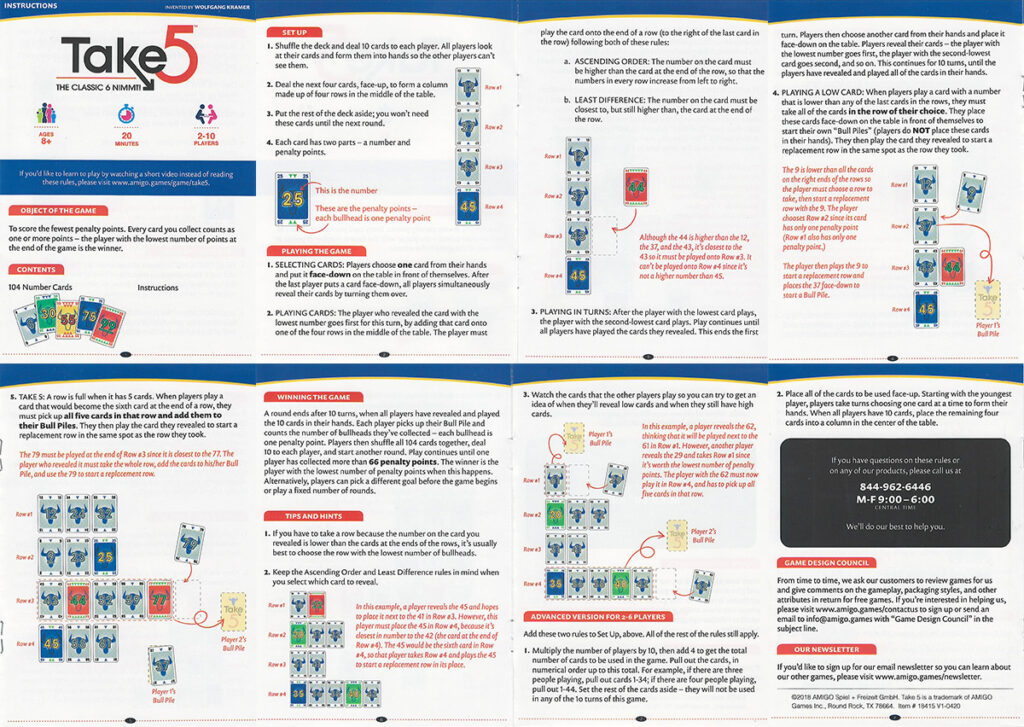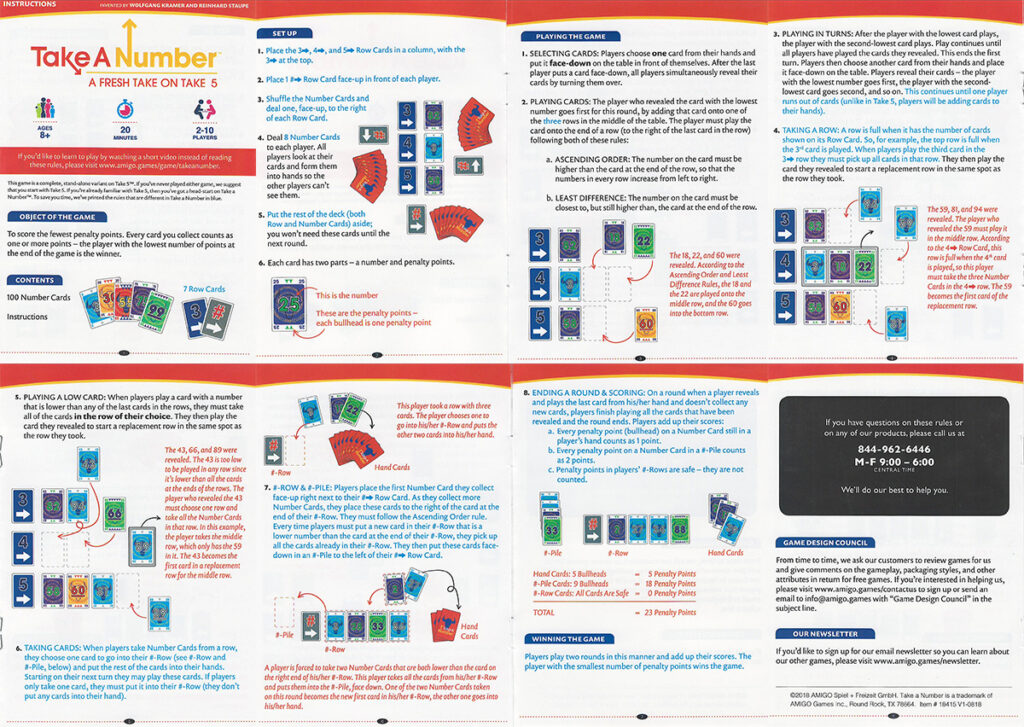
6 Nimmt (translated as 6 Takes, also known as X Nimmt and Take 5) is a favorite among our Patrons when we get a group together for an evening on Board Game Arena. This twist on a trick-taking card game sets up 4 rows that build over time, and when the 6th card is added to a row, you take the preceding 5 cards (hence why the game’s names are what they are).
So what is it that keeps the Meeples and the members of our Patreon coming back for more? Once you see how to play the game, you’ll understand why 6 Nimmt‘s brand of chaos resonates with us so well.
6 Nimmt Card Game Rules
Player Count: 2-10
Estimated Play Time: 20 minutes
6 Nimmt Rules PDF
I’ll be honest, I was surprised 6 Nimmt‘s rulebook had 8 pages. They’re small pages, but this is not a complicated game.
Setup
Shuffle the deck and deal 10 cards to each player. Place the next 4 cards of the deck face up on the table in a vertical line – these will be the starting numbers for the four rows of the board. Keeping your hand secret from your opponents is of the utmost importance in 6 Nimmt, as telling opponents what you have can help them play better against you.
Once cards are dealt, set the rest of the deck aside until the next round. Borrowing from Board Game Arena (BGA), your setup should look similar to the one pictured below (the cards across the top represent your hand)
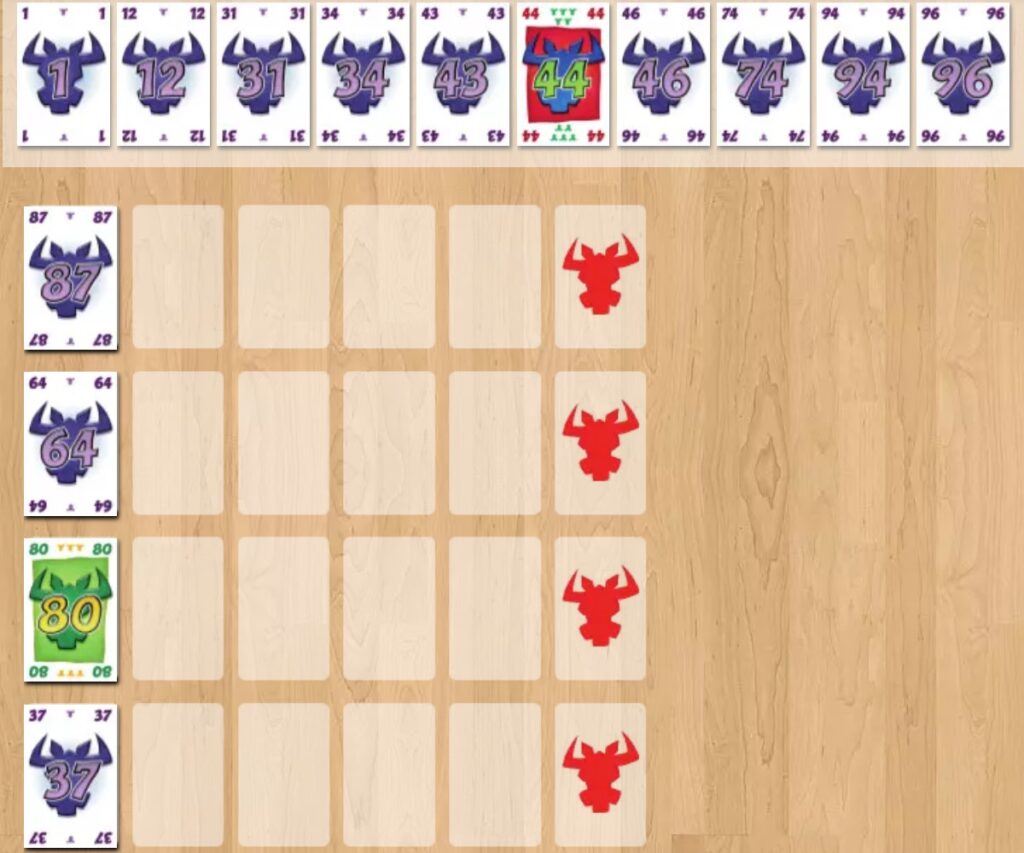
Gameplay
There are 104 cards in the deck, numbered from 1 to 104. Each turn, all players will pick a card from their hand to play and place it face-down in front of them. Once everyone has selected their cards, the cards placed in front of each player are turned face up and assigned to a row.
The lowest card revealed is assigned first, then the 2nd lowest, and so on until all cards have been placed in one of the four rows of the board. To assign a card, look for the row whose next space is closest to your number without going over.
Using our above picture as an example, let’s say I want to play my 74 first. While 74 is closest to 80 numerically, 80 is larger than 74, so I can’t place my 74 there. The next closest number on the board is 64, which is lower than 74, so my 74 is placed to the right of the 64.
Cards are always placed furthest to the right in a row, and all players will continue this pattern of gameplay for each of the ten turns of the round. Rounds continue to be played until someone triggers the end of the game (more on that in a moment).
So what happens if you play a number that is lower than all the rows?
If this should happen, like if I played my 1, you must pick a row to take. The card you played then becomes the first card of that newly emptied row. Going back to the picture above, if I played my 1 first instead of my 74, I’d have to take all the cards in one of the 4 rows, then put my 1 in the first spot of the row I took cards from.
After you take cards, you need to count up how many points you took across your cards. Which brings us to…
Scoring
Taking cards in 6 Nimmt is something you want to avoid as much as possible, as each point is a step closer to losing the game. While the rulebook has you count up from 0 to 66 (66 marking the point where a player has triggered the end of the game), we prefer BGA’s method of counting down from 66 instead, making 0 the threshold for the end of the game.
So what determines how many points a card is worth? Look no further than the number of bulls (or the color) of the cards you take!

- Gray Cards have 1 bull on them, and are worth 1 point each.
- Blue Cards have 2 bulls on them, and are worth 2 points each. These show up on cards whose number is a multiple of 5.
- Green Cards have 3 bulls on them, and are worth 3 points each. These show up on cards whose number is a multiple of 10, replacing potential Blue Cards.
- Red Cards have 5 bulls on them, and are worth 5 points each. These show up on cards whose number is a multiple of 11.
- 55 is the only Yellow Card. It has 7 bulls on it, and is worth 7 points, combining the effects of the Red and Blue cards it is replacing.
The end of the game is triggered when someone has collected 66 Bulls. The round finishes, and then players check their scores. Whether you’re counting up or down from 66, whoever collected the fewest bulls is the winner!
6 Nimmt Strategy Guide
I’m not going to beat around the bush here – luck is a pretty big factor in 6 Nimmt. Despite this being the case though, there are a few things you can do to improve the quality of your moves, allowing you to make your own luck when the board is being less than cooperative.
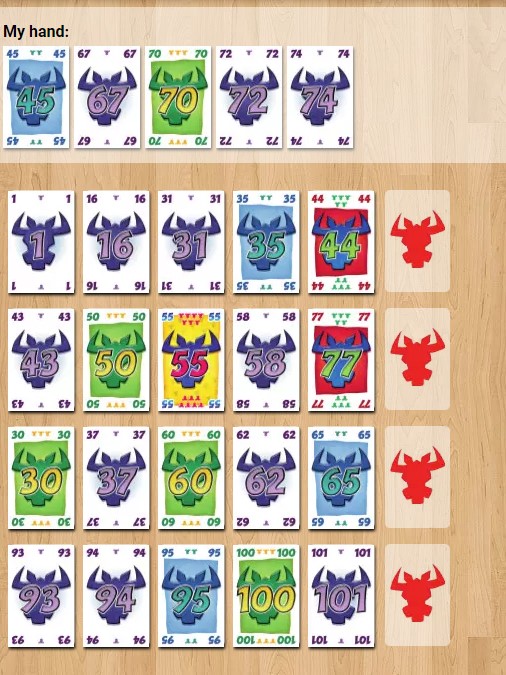
More Players Means Taking Fewer Or Smaller Risks
Each player in a 6 Nimmt game is putting 10 of the 104 cards of the deck into play. This means in a 2 player game, 24 cards will be out, and in a 10 player game, every one of the 104 cards will see play.
If you’re trying to sneak into an empty spot of a row to trick avoid taking points (or trick your opponents into doing so after stealing the free space they wanted), you’re taking some form of risk unless you have the next ascending number (like a 45 after a 44), in which case you have a nearly guaranteed safe play that will only be disrupted by someone taking your row with a really low number.
The more numbers between the last card of a row and the card you want to play, the higher the risk you take that someone will undercut you. The more players there are in a game, the more likely it is a card that can undercut you is in someone’s hand.
Naturally, this makes navigating the board a certifiable nightmare with 10 players, but I’d argue it’s even more treacherous with 8 or 9. Rather than a guarantee that the card(s) you’re worried about are in someone’s hand, there’s a slim chance they’re not.
This can make it really tempting to go for a risky move if there’s a chance of a good payoff, but more often than not, this will blow up in your face in these scenarios. But those times it doesn’t, it’s hard to deny how satisfying the results are.
Pay Attention To The Cards That Have Already Been Played
Big shocker, I know, but counting cards is a very useful skill in 6 Nimmt. Since there’s only 1 copy of each number in the deck, once a given number has been shown, it won’t show up again for the rest of the round.
Knowing precisely what could still be out in someone’s hand and the odds of that card being dealt out can dramatically change the math of a situation that otherwise appears dire at first glance. Suddenly, a play that looks super risky might actually be more likely to succeed than fail.
Try To Get Rid Of Your Highest Cards First
The closer a card is to 104, the more likely it is to force you to take points in the final 3 turns of a round. Rows are usually full of cards and/or bulls by this point, so your only hope is that some poor shmuck has a card that is slightly lower than yours by the time you’re forced to play that high number you stubbornly held all round.
If you are feeling particularly vindictive, this high card can also force the early closure of a row until someone spends a low number to clear it, ratcheting up the risk of each turn dramatically by removing free spaces to play.
Low Cards Can Help Control How Many Points You (Or Others) Take
Low cards can be as problematic as high cards, as a 1 guarantees you’ll be taking at least 1 point, and the closer a card is to 1, the more likely you are to use it to claim a row and the points it contains.
But when you have 3 rows that are loaded with 10+ bulls, and 1 row that’s only got 3 or 4 points in it, sometimes it’s better not to risk getting saddled with a particularly colorful set of cards and opt for the smaller, if guaranteed number of points instead.
As long as someone takes a bad row when you do this, you won’t come out the worst for that turn. That said, you’ll also want to limit how often you use this strategy as a lesser number of points is, after all, still points.
You can also use a low card to disrupt someone else’s play by taking away their safe spot. This can potentially force their card into taking a row instead, which is especially useful if you need to stick the current frontrunner with a few points to bring them back down to Earth.
6 Nimmt Versions & Variations
While the Take 5 box includes an official variation of 6 Nimmt, complete with its own deck, in the box, we’ve also got an unofficial variant that began as an in-joke, then evolved into an entirely different way to play the game that we’ve found to be as fun and challenging as the original!
Take A Number
Take A Number is included when you buy a copy of Take 5, complete with its own deck of 100 numbers and a rulebook.
Take A Number Rules
Player Count: 2-10
Estimated Play Time: 20 minutes
Take A Number Rules PDF
The rules and gameplay aren’t terribly different for the first several pages of rules, but there are a few key differences that set Take A Number apart.
Setup
Setup is the same as 6 Nimmt with three exceptions:
- There are three rows instead of four for gameplay, labelled 3, 4, and 5.
- Players receive 8 cards instead of 10.
- Each player has a special row in front of them Called the #-Row (no idea why only 4 markers for this were included when this plays up to 10, but I digress).
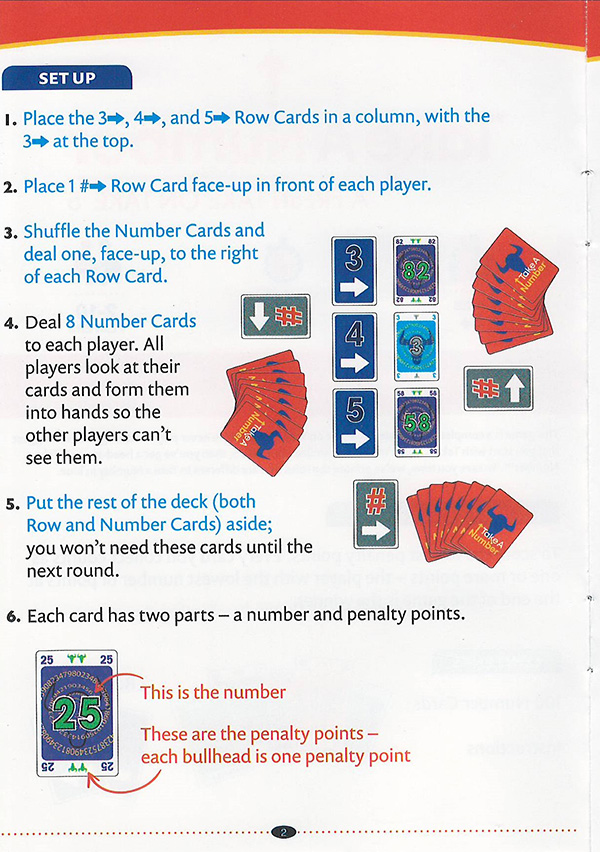
Gameplay
Gameplay is very similar to 6 Nimmt. Each player chooses a card from their hand to play, puts it face down, and then all are revealed and placed as before. The first difference in gameplay comes up at this point, as those labels above dictate the size of the row!
So you’ll be taking cards from the 3 row when it receives its 3rd card, the 4 row when it gets its 4th, and the 5 row when it gets its 5th. But rather than becoming immediate points as before, the cards you take go to your #-Row instead.
The #-Row behaves like any other row – you have to build in ascending order. If you take cards from the 3, 4, or 5 rows that don’t allow you to do this, all cards currently in your #-Row move to your #-Pile face down (like regular points do in 6 Nimmt.
One of the new cards you took then becomes the first card of your #-Row. The rest go into your hand.
The round continues until someone plays the last card in their hand without adding any new cards to their hand. The game ends after 2 rounds have been played.
Scoring
Scoring is somewhat different in Take A Number, though Bulls are still not something you want to collect. The bulls on the 100 number cards are also also dispensed a little differently.

- Blue Cards have 1 bull on them.
- Purple Cards have 2 bulls on them. These show up on cards whose number ends in 2, 5, or 8.
- Yellow Cards have 3 bulls on them. These show up on cards whose number is a multiple of 10, replacing potential Purple Cards.
- Green Cards have 5 bulls on them. These show up on cards whose number is a multiple of 11, replacing potential Purple Cards.
- 55 is the only Red Card. It has 7 bulls on it, combining the effects of the Purple and Green cards it is replacing.
At the end of a round, scoring occurs as follows:
- Every bull in your #-Row is worth 0 points.
- Every bull in your hand is worth 1 point.
- Every bull in your #-Pile is worth 2 points.
Whoever has the lowest score after 2 rounds is the winner!
So yeah, sending cards to your #-Pile is real bad. It feels worse knowing that after sending cards there, the rest of the cards not placed in your #-Row go to your hand, where they’ll still penalize you!
While conventional wisdom suggests the lowest card that forced you to clear out your #-Row should probably be the card that starts the next one, there’s also something to be said for putting the card with the most Bulls on it there, especially if hands are getting low. Otherwise, the 6 Nimmt strategies we covered earlier are also good rules of thumb in Take A Number.
Bull Collector (a.k.a. Tribbles Rules)
Effectively, this is 6 Nimmt backwards. You want to take as many bulls as you can and be the first to trigger the end of the game. While this originated as a chaos factor/consolation prize for the person in last place, when we tried this variant out, it became clear very quickly that this is easier said than done.
Low cards are extremely valuable in this game mode, but timing when to play them is really important, as getting undercut when trying to snag a full row of points will cost you both a powerful card and the row you wanted. Pretty painful.
Targeting your other cards toward the 2nd or 3rd most impressive rows should be a focus of your remaining cards, as they won’t be as hotly contested in the moment. Unless someone feels like be a jerk and taking your points to give someone else theirs. Not that I would know this from experience or anything.
Is 6 Nimmt A Good Game
This is a tough question to give a simple yes or no answer to. In terms of game design, no, not especially. Like many card games, luck can burn you at the most inopportune times, and when you’re playing with a deck that has twice as many cards as a standard one with multiple opponents, I’d sooner try my odds at the poker table, where luck is actually less of a factor.
Despite this shortcoming, however, I can’t help but be drawn to the energy and chaos 6 Nimmt brings to the table. It accommodates 10 people, which many card and board games simply aren’t capable of. Everyone gets to make their move at the same time, so there’s very little downtime.
And most importantly, each turn is exciting – especially if you have a bigger group! You can go from being boxed into a corner one turn to a surprise reversal the next, and everything in between.
People also get really into the game very quickly – if there’s a game where every move after the 3rd or 4th turn doesn’t become a personal attack against someone else at the table, I haven’t seen it yet.
While not for every board game shelf, I’d still recommend 6 Nimmt/Take 5 for a lot of board game groups, especially some of the more casual ones or those that tend to host a lot of people. I’ve gotten a ton of entertainment value out of the $15 I spent on my copy, which goes to show you that a game doesn’t have to be perfectly designed to be a ton of fun.
Other Board Game Articles You’ll Love
- Blokus Rules and Strategy Guide
- Godsforge Expansion Review
- BGA Premium vs Free
- What is a Meeple?
- Splendor Game Strategy: The Ladder
- Smash Up Best Expansions
Braden is a founder of Assorted Meeples and has been a gamer & writer with a vivid imagination all his life. Don’t believe us? Check out his excitement when meeting Goosebumps author R.L. Stine as a kid! An avid Magic: The Gathering spellslinger for over 15 years, you can always convince him to shuffle up for a game (or three!) of Commander.

